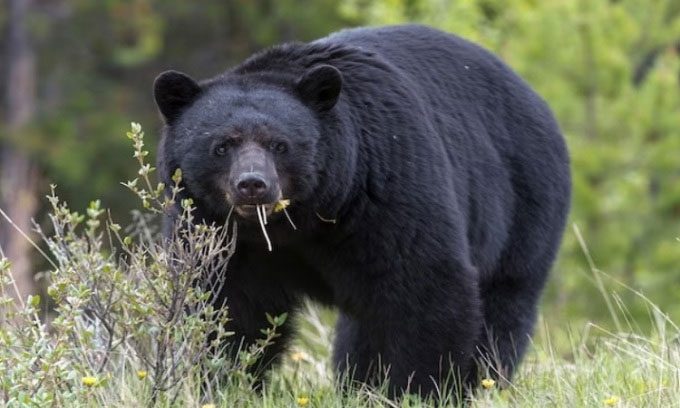Contrary to the portrayal in movies, the 90 kg bear in Georgia died from an overdose after consuming 3 to 4 grams of cocaine and did not exhibit any destructive behavior beforehand.
The true story of the cocaine bear begins with a man named Andrew Carter Thornton II. Born in 1944, he was the son of a famous horse breeder in Kentucky and became a paratrooper in the U.S. Army, even being awarded the Purple Heart during the U.S. invasion of the Dominican Republic in 1965. Thornton was discharged the same year and returned to Kentucky, where he joined the Lexington Police Department’s drug enforcement unit.

The bear that died from cocaine was a black bear. (Photo: Nat Geo)
However, Thornton quickly became more interested in drug trafficking than in combating crime. His adventurous nature pushed him deeper into the drug smuggling trade. In 1981, Thornton was charged with piloting a plane carrying marijuana from South America to Lexington, Kentucky, along with 24 others. Then, in September 1985, Thornton took off on his final drug smuggling mission, jumping from a plane in Knoxville, Tennessee, with a bag containing $15 million worth of cocaine. He died due to a parachute malfunction.
Two months after the smuggler’s death, a hunter in Georgia found the bear’s body with the torn bag nearby. Later, investigators confirmed that it was indeed Thornton’s bag. Medical personnel concluded that the bear, weighing over 90 kg, died from an overdose after ingesting approximately 3 to 4 grams of cocaine. “That amount is enough to kill anyone,” an investigator stated.
Scientists are unsure whether animals experience a high similar to humans when using addictive substances like marijuana or cocaine. While animals eat compounds like catnip, psychedelic mushrooms, and alcohol, there is no way to know if they seek out these substances for recreational effects. However, stimulants do have various effects on animals. For example, reindeer act erratically after consuming mushrooms, and many wild animals become intoxicated after drinking alcohol.
When the cocaine bear was found in the woods, it had been dead for about a month. Contrary to the destructive behavior depicted in films, investigators reported no evidence of any destructive or aggressive actions prior to its death. The bear also did not consume all the cocaine that Thornton had smuggled. Authorities concluded that someone else had used the remaining stash.
According to dream analyst Chris Morgan, while it is likely that the bear experienced physiological reactions after consuming cocaine, its death is not a story about a drug-addicted bear but rather a reflection of how human waste can endanger wildlife. Many cases of animals consuming drugs can be explained by curiosity or hunger. Although accidental exposure to addictive substances is common, it often results from human carelessness or cruelty.
Research shows that as humans increasingly use stimulants, animals are more likely to consume them as well. One study found that dogs are at a higher risk of opioid poisoning in areas with more opioid prescriptions. Cannabis poisoning can even lead to disability or death in dogs and cats.
The cocaine bear is not the only animal threatened by Thornton’s smuggling activities. It was just one of many bags filled with drugs that Thornton discarded across remote areas in Georgia and Tennessee before his fatal parachute jump. At the time of his death, investigators found evidence that Thornton and his accomplices had dropped nearly 400 kg of cocaine in the U.S. However, they did not report any additional cases of bears dying or causing destruction due to cocaine consumption.





















































